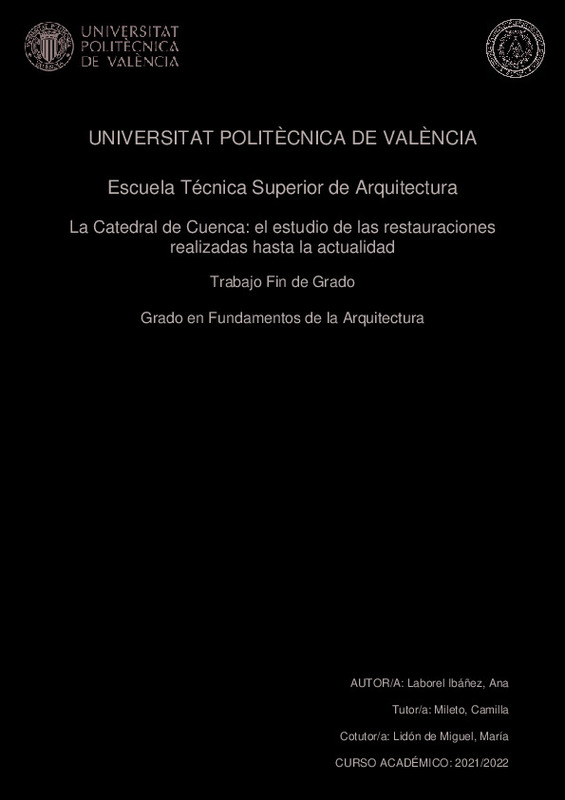|
Resumen:
|
[ES] La Catedral de Cuenca, de estilo gótico en la actualidad, se ha visto modificada numerosas veces a lo largo de los siglos. Situada en el casco histórico de la ciudad, es un edificio emblemático que ha sido objeto de ...[+]
[ES] La Catedral de Cuenca, de estilo gótico en la actualidad, se ha visto modificada numerosas veces a lo largo de los siglos. Situada en el casco histórico de la ciudad, es un edificio emblemático que ha sido objeto de restauraciones conocidas e importantes.
Se quiere desarrollar una investigación sobre las diferentes fases de restauración que se han realizado en la Catedral de Cuenca, desde que fue construida hasta la actualidad, para poner en relación la teoría con la práctica de la restauración en el contexto español. Durante este proceso, se estudiará la historia de la catedral y la historia de sus restauraciones, desde las más conocidas hasta las realizadas en los últimos años, haciendo mayor hincapié en el trabajo llevado a cabo a principios del siglo XX por uno de los representantes de la Escuela Restauradora, Vicente Lampérez y Romea. El objetivo será comprobar cómo sus ideas y la de los distintos restauradores que han intervenido se reflejan en las acciones realizadas sobre el edificio.
La investigación comenzará con la recopilación de documentación, en la medida de lo posible, procedente de fuentes originales. Este trabajo de revisión se complementará con el estudio detallado del edificio y con la información dada por los trabajadores a cargo de la conservación de la catedral hoy en día. El propósito será conocer en profundidad la historia del edificio y la de sus restauraciones, viendo qué criterios siguieron y de qué manera se pusieron en práctica. El análisis se centrará, especialmente, en las obras dirigidas por Vicente Lámperez y que han marcado la estética de la catedral en la actualidad.
Se espera que este trabajo contribuya a ampliar el conocimiento que se tiene sobre este emblemático edificio, sobre sus intervenciones y sobre la teoría restauradora de Vicente Lampérez. Se pretende, finalmente, que este conocimiento pueda ser útil para la puesta en valor y la conservación que se hace actualmente del edificio.
[-]
[EN] Cuenca Cathedral, now Gothic in style, has been modified numerous times over the centuries. Located in the historic centre of the city, it is an emblematic building that has been the object of well-known and important ...[+]
[EN] Cuenca Cathedral, now Gothic in style, has been modified numerous times over the centuries. Located in the historic centre of the city, it is an emblematic building that has been the object of well-known and important restorations.
The aim is to carry out research into the different phases of restoration that have been carried out on Cuenca Cathedral, from the time it was built until the present day, in order to relate the theory and practice of restoration in the Spanish context. During this process, the history of the cathedral and the history of its restorations will be studied, from the best known to those carried out in recent years, with particular emphasis on the work carried out at the beginning of the 20th century by one of the representatives of the Restoration School, Vicente Lampérez y Romea. The aim will be to see how his ideas and those of the various restorers who have intervened are reflected in the actions carried out on the building.
The research will begin with the compilation of documentation, as far as possible, from original sources. This review work will be complemented with the detailed study of the building and with the information given by the workers in charge of the conservation of the cathedral today. The purpose will be to gain an in-depth knowledge of the history of the building and that of its restorations, seeing what criteria they followed and how they were put into practice. The analysis will focus especially on the works directed by Vicente Lámperez that have marked the aesthetics of the cathedral today.
It is hoped that this work will contribute to broadening our knowledge of this emblematic building, of his interventions and of Vicente Lampérez's theory of restoration. Finally, it is hoped that this knowledge may be useful for the current enhancement and conservation of the building.
[-]
|







